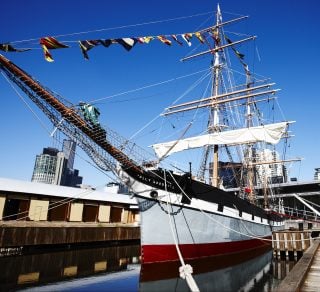A recent Polly Woodside research project* has brought to life new stories about conservation, collegiality, enduring passions and commitment.
Last year marked the 50th anniversary of the start of the volunteer supported conservation work on the Polly Woodside. To commemorate this milestone, the Trust commissioned a study to audit and document existing resources and to identify new storylines for our largest Collection object.
Early Days
The significance of the languishing iron barque Polly Woodside (then the Rona) was recognised in the early 1960s by two men with a passion for preservation, seaman Karl Kortum of San Francisco and Dr E Graeme Robertson, NTAV committee member, cast iron expert and chairman of the NTAV Cast Iron Committee.
Robertson formed the Polly Woodside Ship Watching Committee (SWC) with eight other members drawn from ex sailing masters and the Shiplovers’ Society to monitor and lobby for the ship. In 1968, the Rona’s owners Howard Smith Industries Pty Ltd handed over the ship to the Trust by bill of sale for one cent.
A decision was made to restore the ship to its earlier life as the Polly Woodside and the SWC was renamed the Polly Woodside Restoration Committee (PWRC).
Specification drawings, preliminary work and fundraising appeals commenced and in 1972 a coordinated program using volunteers to help restore the ship began.
Now
Fifty years later, the volunteer conservation program remains active and participants meet weekly to continue maintenance work on Polly Woodside. Researcher/historians Mandy Bede and Alison Cowan, who were engaged to undertake the project, interviewed past and current volunteers and delved into archives and photo collections.
They identified:
“It has been a great pleasure to learn about Polly Woodside and the enormous efforts that have been made to rebuild her from a coal hulk. Our project has added to the documentation of this achievement. It has been sobering to see a project that has relied on 100s of volunteers over many years now has a workforce of 5 or 6 regular volunteers. The stories associated with Polly Woodside illustrate the power of a project that inspired a community of individuals and corporations in the 1970s particularly.”
- There has been co-operation between volunteers and trade unions, including unionists working consistently and professionally on unpaid parts of the project.
- There have been skilled workers guiding keen volunteers as diverse as SEC linesmen and dentists.
- There has been co-operation and goodwill on a project where there was some 20th century trial and error when approaching 19th century problems.
- There have been even today, old skills like splicing and rope knotting employed on small projects around the ship.
- The two lead volunteers, both aged over 80, are still committed to the ship. That commitment includes making plans to find the next generation of volunteers.
The research study has provided fresh perspectives and revealed new stories about the Polly Woodside as a historic vessel and as an important catalyst and example of community action and involvement. The Trust looks forward to developing and sharing these stories and is indebted to the 100s of volunteers who have so generously given, and continue to give, their time, talents and expertise to ensure Polly Woodside is conserved for the enjoyment of future generations.
*This research project was generously supported by a grant from the Maritime Museums of Australia Project Support Scheme (MMAPSS) funded by the Australian Government through the Australian National Maritime Museum and the Department of Infrastructure, Transport, Regional Development and Communications


